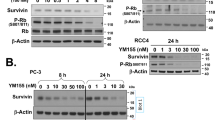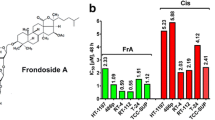Abstract
Purpose
4-[2-(2-Amino-4-oxo-4,6,7,8-tetrahydro-3H-pyrimidino[5,4,6][1,4] thiazin-6-yl)-(S)-ethyl]-2,5-thienoylamino-l-glutamic acid (AG2034), is a classical antifolate, an analog of folic acid that has been shown to be an excellent inhibitor of glycinamide ribonucleotide formyltransferase (GARFT), ultimately inhibiting the de novo synthesis of purines. We examined the effect of this drug on cell proliferation, steady-state ATP levels, de novo and hypoxanthine salvage ATP synthesis, and on the phosphorylation of AMP kinase, in two different androgen independent prostate cancer cell lines, DU145 and PC-3.
Methods
Cells were maintained in culture medium containing 10 nM 5-methyl tetrahydrofolate supplemented with or without 1.7 μM hypoxanthine and 1.5 μM thymidine. Cytotoxicity of AG2034 was determined by clonogenic assays. AG2034-induced inhibition of cell proliferation was determined by electronic counting of cells over varying periods of time. Total cellular AMP and ATP pre- and post-drug treatment was quantified by reverse-phase HPLC. [14C]-Glycine incorporation and [3H]-hypoxanthine conversion into ATP were determined by liquid scintillation counting of HPLC isolated ATP fractions. The phosphorylation of AMP kinase (AMPK) was detected by western blotting.
Results
In the absence of 1.7 μM hypoxanthine, AG2034 was cytotoxic to both DU145 and PC-3 cells. In its presence, the cells remained cytostatic for 14 days after which time DU145 but not PC-3 re-initiated growth that was maintained for 35 days even though steady-state levels of ATP in both cell lines remained depleted and [14C]-glycine incorporation into ATP was inhibited by >95%. Salvage purine synthesis as measured by incorporation of [3H]-hypoxanthine into ATP was maintained in both cell lines albeit to different levels. When AG2034 was added to the culture medium in the presence or absence of 1.7 μM hypoxanthine, cellular ATP levels were reduced by 80% within 24 h in both the cell lines. In the absence of hypoxanthine, the AMP/ATP ratio in PC-3 cells increased by 38% and was accompanied by a modest increase in the level of phosphorylated AMPK; no increase was observed in the presence of hypoxanthine where the AMP/ATP ratio increased by approximately 10%. Under these same culture conditions, the AMP/ATP ratio in DU145 cells in the absence of hypoxanthine increased by 60% and was accompanied by a large increase in phosphorylated AMPK. In the presence of hypoxanthine however, even though the AMP/ATP ratio increased 2.5-fold, phosphorylated AMPK levels did not increase.
Conclusions
The cytostatic versus the cytotoxic effect of AG2034 on PC-3 and DU145 cells is mediated by the presence or absence, respectively, of physiological levels of hypoxanthine (1.7 μM) in the media. The ability of DU145 as opposed to PC-3 cells to proliferate in the presence of AG2034 is independent of the intracellular concentration of ATP. Activation of the AMPK signaling pathway in drug-treated PC-3 and DU145 cells is cell line dependent and independent of the AMP/ATP ratio.








Similar content being viewed by others
Abbreviations
- AG2034:
-
4-[2-(2-Amino-4-oxo-4,6,7,8-tetrahydro-3H-pyrimidino[5,4,6][1,4] thiazin-6-yl)-(S)-ethyl]-2,5-thienoylamino-l-glutamic acid
- FBS:
-
Fetal bovine serum
- csd-FBS:
-
Charcoal stripped and dialyzed-FBS
- GARFT:
-
Glycinamide ribonucleotide formyltransferase
- FPGS:
-
Folylpolyglutamate synthase
- DPBS:
-
Dulbecco’s phosphate buffered saline solution
- HPX:
-
Hypoxanthine
- FA-Plus medium:
-
MEM/F12 medium (deficient in hypoxanthine, thymidine, folate, l-glutamine and phenol red) supplemented with 10% csd-FBS, 1.7 μM hypoxanthine, 1.5 μM thymidine, 0.05 nM R1881 hormone, 10 nM 5-methyl tetrahydrofolate, penicillin (100 units/ml)/streptomycin (100 μg/ml) and 2 mM l-glutamine
- FA medium:
-
FA-Plus without hypoxanthine and thymidine
References
Allegra CJ, Chabner BA, Drakes JC, Lutz R, Rodbard D, Jolivet J (1985) Enhanced inhibition of thymidylate synthase by methotrexate polyglutamates. J Biol Chem 260:9720–9726
Allegra CJ, Drake JC, Jolivet J, Chabner BA (1985) Inhibition of phosphoribosylaminoimidazole carboxamide transformylase by methotrexate and dihydrofolate polyglutamylates. Proc Natl Acad Sci USA 82:4881–4885
Bartlett CA, Boritzki TJ, Dagostino EF, Margosiak SA, Palmer CL, Romines WH, Varney MD (1999) Biological properties of AG2037: a new inhibitor of glycinamide ribonucleotide formyltransferase with low affinity for the folate receptor. Proc Am Assoc Cancer Res 40:291
Beardsley GP Moroson BA, Taylor EC, Moran RG (1989) A new folate antimetabolite, 5,10-dideaza-5,6,7,8-tetrahydrofolate is a potent inhibitor of de novo purine synthesis. J Biol Chem 264:328–333
Bissett D, McLeod HL, Sheedy B, Collier M, Pithavala Y, Paradiso L, Pitsiladis M, Cassidy J (2001) Phase I dose-escalation and pharmacokinetic study of a novel folate analogue AG2034. Br J Cancer 84:308–312
Boritzki TJ, Barlett CA, Zhang C, Howland EE, Margosiak SA, Palmer CL, Romines WH, Jackson RC (1996) AG2034: a novel inhibitor of glycinamide ribonucleotide formyltransferase. Invest New Drugs 14:295–303
Bosson G (2003) Reduced folate carrier: biochemistry and molecular biology of the normal and methotrexate-resistant cell. Br J Biomed Sci 60:117–129
Bronder JL, Moran RG (2002) Antifolates targeting purine synthesis allow entry of tumor cells into S phase regardless of p53 function. Cancer Res 62:5236–5241
Bronder JL Moran RG (2003) A defect in the p53 response pathway induced by de novo purine synthesis inhibition. J Biol Chem 278:48861–48871
Chabner BA, Allegra CJ, Curt GA, Clendeninn NJ, Baram J, Kolzumi S, Drake JC, Jolivet J (1985) Polyglutamylation of methotrexate. Is methotrexate a prodrug? J Clin Invest 76:907–912
Chen Z, Lu W, Garcia-Prieto C, Huang P (2007) The Warburg effect and its cancer therapeutic implications. J Bioenerg Biomembr [Epub ahead of print doi:10.1007/s10863-007-9086-x]
Chintalacharuvu S, Evans GF, Shih C, Bryant HU, Sandusky GE, Zuckerman SH (2005) Inhibition of glycinamide ribonucleotide formyltransferase results in selective inhibition of macrophage cytokine secretion in vitro and in vivo efficacy in rat adjuvant arthritis. Clin Exp Rheumatol 23:438–446
Corton JM, Gillespie JG, Hawley SA, Hardie DG (1995) 5-aminoimidazole-4-carboxamide ribonucleoside. A specific method for activating AMP-activated protein kinase in intact cells. Eur J Biochem 229(2):558–565
Franklin RB, Costello LC (1997) Intermediary energy metabolism of normal and malignant prostate epithelial cells. In: Naz RK (ed) Prostate: basic and clinical aspects. CRC, New York, p 115
Gangjee A, Elzein E, Kothare M, Vasudevan A (1996) Classical and nonclassical antifolates as potential antitumor, antipneumocystis and antitoxoplasma agents. Curr Pharm Des 2:263–280
Hardie DG, Hawley SA, Scott JW (2006) AMP-activated protein kinase- development of the energy sensor concept. J Physiol 574:7–15
Jackson RC, Harkrader RJ (1981) The contributions of de novo and salvage pathways of nucleotide biosynthesis in normal and malignant cells. In: Tattersall MHN, Fox RM (eds) Nucleosides and cancer treatment. Academic, Sydney, p 18
Kemp BE, Mitchelhill KI, Stapleton D, Michell BJ, Chen ZP, Witters LA (1999) Dealing with energy demand: the AMP-activated protein kinase. Trends Biochem Sci 24:22–25
Lu X, Errington J, Chen VJ, Curtin NJ, Boddy AV, Newell DR (2000) Cellular ATP depletion by LY309887 as a predictor of growth inhibition in human tumor cell lines. Clin Cancer Res 6:271–277
Melera PW (2002) Resistance to inhibitors of dihydrofolate reductase, 2nd edn. In: Bertino JR (ed) Encyclopedia of cancer, vol IV. Academic, New York, p 115
Moreno-Sanchez R, Rodriguez-Enriquez S, Marin-Hernandez A, Saavedra E (2007) Energy metabolism in tumor cells. FEBS J 274:1393–1418
Ray MS, Muggia FM, Leichman CG, Grunberg SM, Nelson RL, Dyke RW, Moran RG (1993) Phase 1 study of (6R)-5, 10-dideazatetrahydrofolate: a folate antimetabolite inhibitory to de novo purine synthesis. J Natl Cancer Inst 85:1154–1159
Rhodes DR, Barrette TR, Rubin MA, Ghosh D, Chinnaiyan AM (2002) Meta-analysis of microarrays: Interstudy validation of gene expression profiles reveals pathway dysregulation in prostate cancer. Cancer Res 62:4427–4433
Scagliotti GV, Selvaggi G (2006) Antimetabolites and cancer: emerging data with a focus on antifolates. Expert Opin Ther Pat 16:189–200
Sellevold OFM, Jynge P, Aarstad K (1986) High performance liquid chromatography: a rapid isocratic method for determination of creatine compounds and adenine nucleotides in myocardial tissue. J Mol Cell Cardiol 18:517–527
Smith SG, Lehman NL, Moran RG (1993) Cytotoxicity of antifolate inhibitors of thymidylate and purine synthesis to WiDr colonic carcinoma cells. Cancer Res 53:5697–5706
Warburg O (1956) On the origin of cancer cells. Science 123:309–314
Weber G, Nagai M, Natsumeda Y, Ichikawa S, Nakamura H, Eble JN, Jayaram HN, Zhen WN, Paulik E, Hoffman R et al (1991) Regulation of de novo and salvage pathways in chemotherapy. Adv Enzyme Regul 31:45–67
Xiang X, Saha AK, Wen R, Ruderman NB, Luo Z (2004) AMP-activated protein kinase activators can inhibit the growth of prostate cancer cells by multiple mechanisms. Biochem Biophys Res Commun 321:161–167
Zhang CC, Boritzki TJ, Jackson RC (1998) An inhibitor of glycinamide ribonucleotide formyltransferase is selectively cytotoxic to cells that lack a functional G1 checkpoint. Cancer Chemother Pharmacol 41:223–228
Zhu W-Y, Melera PW (2001) Basal levels of metallothionein I and II expression in mouse embryo fibroblasts enhance growth in low folate through a cell cycle mediated pathway. Cell Biology Int 25:1261–1269
Acknowledgments
We thank Pfizer (Groton, CT) for the supply of AG2034 used in this study and Ms. Jenni DiCapua for technical support.
Author information
Authors and Affiliations
Corresponding author
Rights and permissions
About this article
Cite this article
Obajimi, O., Melera, P.W. The depletion of cellular ATP by AG2034 mediates cell death or cytostasis in a hypoxanthine-dependent manner in human prostate cancer cells. Cancer Chemother Pharmacol 62, 215–226 (2008). https://doi.org/10.1007/s00280-007-0593-6
Received:
Accepted:
Published:
Issue Date:
DOI: https://doi.org/10.1007/s00280-007-0593-6




